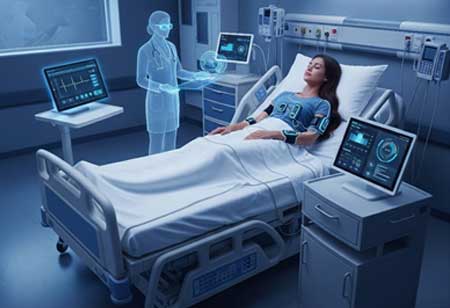Thank you for Subscribing to Healthcare Business Review Weekly Brief
Be first to read the latest tech news, Industry Leader's Insights, and CIO interviews of medium and large enterprises exclusively from Healthcare Business Review
Connected Health: The Future of Patient Monitoring and Engagement
Remote patient monitoring (RPM) enhances healthcare by utilizing technology for proactive care, addressing challenges like data security and patient engagement while offering opportunities through AI, advanced wearables, and personalized.

By
Healthcare Business Review | Friday, August 08, 2025
Stay ahead of the industry with exclusive feature stories on the top companies, expert insights and the latest news delivered straight to your inbox. Subscribe today.
In recent years, remote patient monitoring (RPM) services have significantly reshaped the healthcare sector, offering new avenues for patient care, cost reduction, and better health outcomes. This transformation is driven by technological advancements and the growing demand for more personalized and efficient healthcare. With healthcare systems globally under increasing pressure to manage rising costs, increasing patient populations, and the shift to value-based care, RPM presents an innovative solution. Yet, as with any rapidly growing industry, there are challenges to address and opportunities waiting to be seized.
The Rise of Digital Health Solutions
RPM services have grown from a niche offering to a mainstream component of modern healthcare delivery. Integrating sensors, wearables, and mobile devices into everyday healthcare has given rise to a new era of proactive care. Healthcare providers can monitor chronic conditions, track vital signs, and intervene early—often preventing hospital readmissions or the escalation of diseases. For patients, RPM represents an easier and less invasive way to manage their health, keeping them in control of their well-being without frequent doctor visits.
But it's not just chronic conditions that have made RPM its mark. The COVID-19 pandemic accelerated adoption, particularly as healthcare systems scrambled to manage patient care while minimizing physical interactions. With this shift, there has been a noticeable uptake in remote consultations, virtual monitoring of post-operative patients, and even the integration of telehealth platforms with RPM technology. As a result, RPM has become a central element in broader efforts to digitize healthcare, contributing to a more connected, efficient, and patient-centric healthcare ecosystem.
Addressing Industry Challenges: Security, Data Integration, and Patient Engagement
Despite the excitement around RPM, the industry faces several challenges that need to be tackled for its sustained growth and success. The most significant of these challenges is the security and privacy of patient data. With healthcare data being one of the most valuable and targeted sectors for cybercriminals, ensuring the security of the information being transmitted via RPM platforms is paramount. Implementing robust encryption and compliance with strict regulations like HIPAA and GDPR are mandatory steps for companies looking to instill trust among their users.
Another challenge is the integration of data from disparate sources. RPM systems generate vast amounts of data through sensors, devices, and wearables. Still, this data must be harmonized with other patient information to provide a comprehensive view of an individual's health. For healthcare providers to act on this data effectively, seamless integration with electronic health records (EHRs) is essential. Achieving this interoperability remains a work in progress. However, ongoing efforts are being made to build more cohesive systems, allowing easier data transfer and analysis across platforms.
Patient engagement also remains a key hurdle in scaling RPM. While technology advances, many patients still struggle to adopt new health technologies. Education and ongoing support are necessary to ensure patients use the systems correctly and are motivated to engage with their health data. Healthcare providers must foster trust and guide patients to ensure these tools are used to their full potential.
Seizing Opportunities: Innovations and the Future of RPM
RPM has enormous development potential, but overcoming current obstacles through partnerships and new technology is crucial to success. One of the most promising trends in the industry is the use of artificial intelligence (AI) and machine learning (ML) in RPM platforms. AI algorithms are being used to analyze extensive amounts of health data, identify patterns, and even predict health events before they occur. For example, AI can help detect early signs of a heart attack by monitoring vital signs or predicting a diabetic crisis based on trends in blood glucose levels. These advancements in predictive analytics help healthcare providers intervene earlier and reduce the burden on clinicians by automating routine tasks.
Another area of innovation is the development of more sophisticated wearables. Devices beyond fitness tracking are now being used to monitor critical health metrics in real-time, such as heart rate variability, oxygen levels, and even sleep patterns. As these wearables become more advanced and comfortable, they will likely be incorporated into mainstream healthcare routines, further integrating RPM into everyday life.
The potential for remote monitoring to improve outcomes extends into personalized medicine as well. As RPM technologies evolve, they allow for increasingly precise, individualized care. For example, patients with complex conditions may receive tailored monitoring and treatment based on real-time data, allowing for a more personalized healthcare experience. In addition, using RPM can help healthcare systems move toward more preventative care models, where issues are addressed before they require extensive treatments.
Finally, partnerships between healthcare providers, technology developers, and insurance companies will be critical for expanding RPM's reach and effectiveness. With the growing emphasis on value-based care, insurers are increasingly considering incorporating RPM into their offerings, recognizing that proactive care can reduce overall healthcare costs. Healthcare providers, too, are beginning to realize that RPM can help improve patient outcomes while reducing the strain on their physical infrastructure, ultimately leading to more sustainable practices.






